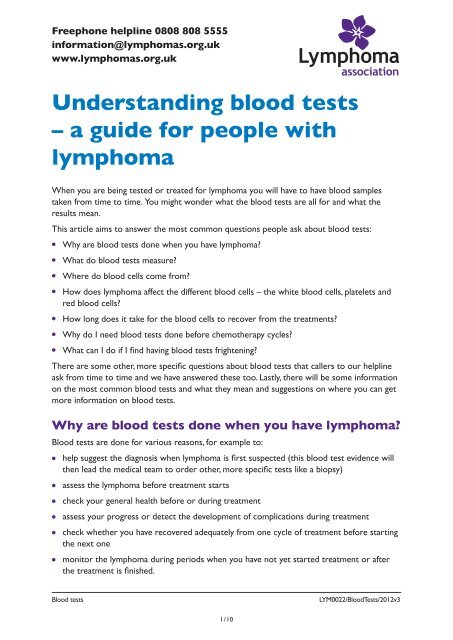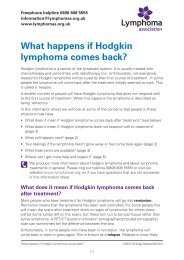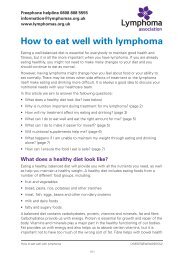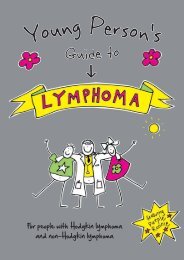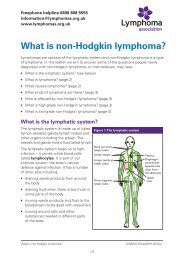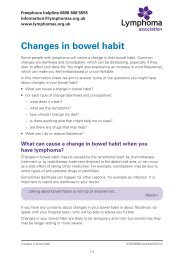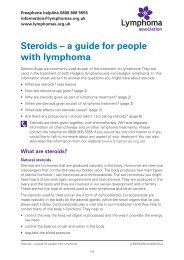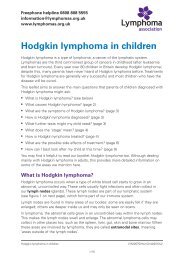Understanding blood tests â a guide for people with lymphoma
Understanding blood tests â a guide for people with lymphoma
Understanding blood tests â a guide for people with lymphoma
You also want an ePaper? Increase the reach of your titles
YUMPU automatically turns print PDFs into web optimized ePapers that Google loves.
Freephone helpline 0808 808 5555in<strong>for</strong>mation@<strong>lymphoma</strong>s.org.ukwww.<strong>lymphoma</strong>s.org.uk<strong>Understanding</strong> <strong>blood</strong> <strong>tests</strong>– a <strong>guide</strong> <strong>for</strong> <strong>people</strong> <strong>with</strong><strong>lymphoma</strong>When you are being tested or treated <strong>for</strong> <strong>lymphoma</strong> you will have to have <strong>blood</strong> samplestaken from time to time. You might wonder what the <strong>blood</strong> <strong>tests</strong> are all <strong>for</strong> and what theresults mean.This article aims to answer the most common questions <strong>people</strong> ask about <strong>blood</strong> <strong>tests</strong>:● Why are <strong>blood</strong> <strong>tests</strong> done when you have <strong>lymphoma</strong>?● What do <strong>blood</strong> <strong>tests</strong> measure?● Where do <strong>blood</strong> cells come from?● How does <strong>lymphoma</strong> affect the different <strong>blood</strong> cells – the white <strong>blood</strong> cells, platelets andred <strong>blood</strong> cells?● How long does it take <strong>for</strong> the <strong>blood</strong> cells to recover from the treatments?● Why do I need <strong>blood</strong> <strong>tests</strong> done be<strong>for</strong>e chemotherapy cycles?● What can I do if I find having <strong>blood</strong> <strong>tests</strong> frightening?There are some other, more specific questions about <strong>blood</strong> <strong>tests</strong> that callers to our helplineask from time to time and we have answered these too. Lastly, there will be some in<strong>for</strong>mationon the most common <strong>blood</strong> <strong>tests</strong> and what they mean and suggestions on where you can getmore in<strong>for</strong>mation on <strong>blood</strong> <strong>tests</strong>.Why are <strong>blood</strong> <strong>tests</strong> done when you have <strong>lymphoma</strong>?Blood <strong>tests</strong> are done <strong>for</strong> various reasons, <strong>for</strong> example to:● help suggest the diagnosis when <strong>lymphoma</strong> is first suspected (this <strong>blood</strong> test evidence willthen lead the medical team to order other, more specific <strong>tests</strong> like a biopsy)● assess the <strong>lymphoma</strong> be<strong>for</strong>e treatment starts● check your general health be<strong>for</strong>e or during treatment● assess your progress or detect the development of complications during treatment● check whether you have recovered adequately from one cycle of treatment be<strong>for</strong>e startingthe next one● monitor the <strong>lymphoma</strong> during periods when you have not yet started treatment or afterthe treatment is finished.Blood <strong>tests</strong>LYM0022/BloodTests/2012v31/10
This briefing paper is based on the study “Effectiveness of the Double Counting mechanism” commissionedby ePURE and carried out by Meo Carbon Solutions. ePURE received financial support from Novozymes tocarry out this study.Published in March 2013.Photo credits: Novozymes
The full <strong>blood</strong> countA full <strong>blood</strong> count (FBC <strong>for</strong> short) is done to look at the numbers of the different typesof <strong>blood</strong> cells in your <strong>blood</strong>. The machine in the laboratory also gives an indication of theaverage sizes of the cells and other useful in<strong>for</strong>mation about them.In some cases a <strong>blood</strong> smear is prepared from the sample and is specially stained to look atthe cells directly under the microscope. This test gives the doctors more detailed in<strong>for</strong>mationon the <strong>blood</strong> cells, <strong>for</strong> example on whether they look normal in size and shape.Blood smear under the microscope showing red and white <strong>blood</strong> cells(Science Photo Library / C012/4499)The numbers of <strong>blood</strong> cells (the ‘counts’) and their appearance can help in the diagnosis ofsome <strong>lymphoma</strong>s. There is some more in<strong>for</strong>mation on the FBC in the table on page 9.Why do <strong>lymphoma</strong> treatments affect the <strong>blood</strong> counts?Treatments such as chemotherapy and radiotherapy are used to kill off <strong>lymphoma</strong> cells butun<strong>for</strong>tunately these treatments don’t distinguish between normal cells and abnormal cells.This means that the numbers of your normal bone marrow cells are often reduced bythe treatments. In addition, your bone marrow might not be working very well if there is<strong>lymphoma</strong> in the marrow itself.This reduction in bone marrow cells means that fewer normal <strong>blood</strong> cells are manufactured.Fortunately, normal cells recover from the effects of the drugs faster than cancer cells, so the<strong>blood</strong> cells usually recover quite quickly and the counts go up again.What are the main types of <strong>blood</strong> cell that are assessed in the FBC?The main types of <strong>blood</strong> cells measured in the FBC are red <strong>blood</strong> cells, white <strong>blood</strong> cells andplatelets. Red <strong>blood</strong> cells are the most numerous of the different <strong>blood</strong> cells but we are goingto describe the white <strong>blood</strong> cells first. This is because they are the cells that are most affectedby <strong>lymphoma</strong> and by <strong>lymphoma</strong> treatments.Blood <strong>tests</strong>LYM0022/BloodTests/2012v33/10
White <strong>blood</strong> cells and <strong>lymphoma</strong>What do white <strong>blood</strong> cells do?There are several types of white <strong>blood</strong> cell, all of which are involved in different ways indefending the body against infection and in clearing up after infections. White <strong>blood</strong> cells arealso involved in our general immunity to infections, in inflammation and in allergic reactions.The numbers of white <strong>blood</strong> cells and their appearance in the FBC and in a <strong>blood</strong> smear canoccasionally help to detect a <strong>lymphoma</strong> and suggest what kind of <strong>lymphoma</strong> it is.Are white <strong>blood</strong> cells affected by <strong>lymphoma</strong> treatment?Yes, the white <strong>blood</strong> cell counts often fall. For <strong>people</strong> who are being treated <strong>for</strong> <strong>lymphoma</strong> theimportant white <strong>blood</strong> cells are the neutrophils. These only last in the <strong>blood</strong>stream <strong>for</strong> a fewdays and they normally ingest (eat) and destroy bugs. This means that you can have problems <strong>with</strong>infections if the bone marrow can’t produce them and you have fewer of them <strong>for</strong> a while.What does having a low neutrophil count mean to me?Having a low neutrophil count is called neutropenia. Getting an infection in this situation canbe very serious. Because you don’t have your normal defences, bugs that are normally harmlesscan overwhelm you. You might need intravenous antibiotics and other support to get over this,often in hospital.If you are unwell <strong>with</strong> a fever during your chemotherapy cycles you must there<strong>for</strong>e seek advicequickly. If you are also on steroids these can mask the fever, so if you feel distinctly unwell, even<strong>with</strong> a normal temperature, you should contact your medical team straightaway. You shouldhave been given telephone numbers from your treatment centre to call at any time of the dayor night in these circumstances – it is important to use them.Platelets and <strong>lymphoma</strong>What do platelets do?Platelets are small cell fragments that help your <strong>blood</strong> to clot. They plug any cuts or defects inthe <strong>blood</strong> vessels while the chemical clotting factors in your <strong>blood</strong> get to work to stabilise theplug. This plug then scars over and heals. The number of platelets measured in the FBC cansometimes be low in certain types of <strong>lymphoma</strong> that are present in the bone marrow. A lowlevel of platelets is called thrombocytopenia.Are platelets affected by <strong>lymphoma</strong> treatment?The production of platelets is affected by <strong>lymphoma</strong> treatments in just the same way as white<strong>blood</strong> cells are affected. Platelets last <strong>for</strong> longer in the <strong>blood</strong>stream so platelet levels don’t tendto drop so far. It is there<strong>for</strong>e not so common to need treatment <strong>for</strong> low platelet counts whenyou are on <strong>lymphoma</strong> treatment, but this will depend on whether there is <strong>lymphoma</strong> in thebone marrow and on how intense the treatment is.How would I know if I have low platelets?A low platelet count won’t affect how you feel in yourself but can mean that you bruise orbleed easily, to a much greater extent than you would normally expect from minor injuries,Blood <strong>tests</strong>LYM0022/BloodTests/2012v34/10
<strong>for</strong> example. You might notice tiny areas of bleeding in the skin as little red spots on yourlower legs – this is known as purpura. If you are bruising or bleeding from a lack of plateletproduction, then a platelet transfusion (a bag of platelets from a donor) can be given totide you over. Rarely, low levels of platelets can happen <strong>for</strong> other reasons and alternativetreatments might be needed, rather than platelet transfusions (eg steroids).Red <strong>blood</strong> cells and <strong>lymphoma</strong>What do red <strong>blood</strong> cells do?Red <strong>blood</strong> cells are much more numerous in the <strong>blood</strong> than the other cells, which is why<strong>blood</strong> is deep red in colour. The red cells contain a protein called haemoglobin, and oxygenthat has been breathed into the lungs attaches itself to this protein as the <strong>blood</strong> passesthrough the lungs. The job of red <strong>blood</strong> cells is there<strong>for</strong>e to carry oxygen around the body.If your red <strong>blood</strong> cell count is low or if the amount of haemoglobin in the red <strong>blood</strong> cells islow, this is called anaemia, which can make you feel tired and breathless. Some <strong>people</strong> <strong>with</strong><strong>lymphoma</strong> will be anaemic when the <strong>lymphoma</strong> is first diagnosed.Are red <strong>blood</strong> cells affected by <strong>lymphoma</strong> treatment?Yes, but they are fairly long-lived cells (they last <strong>for</strong> months rather than days), so you canoften keep your oxygen-carrying capacity up reasonably well during chemotherapy. However,if you are anaemic to start <strong>with</strong>, have <strong>lymphoma</strong> in your bone marrow or have treatmentcomplications, a <strong>blood</strong> transfusion is sometimes necessary. If your chemotherapy is prolonged,the production of red <strong>blood</strong> cells in the bone marrow might be halted <strong>for</strong> so long thattransfusion becomes inevitable.How long does it take <strong>for</strong> <strong>blood</strong> cells to recover fromthe treatments?This varies between different chemotherapy regimens and between individuals. With thestandard outpatient chemotherapy regimens used <strong>for</strong> most <strong>lymphoma</strong>s, the lowest point inthe cell counts (you might hear this referred to as the ‘nadir’) usually comes 7–14 days afterthe first day of the chemotherapy treatment cycle. After this low point the cell counts beginto rise. Because there is variation between <strong>people</strong> in how quickly this happens, however, your<strong>blood</strong> counts will be checked be<strong>for</strong>e each cycle of treatment.Why do I need <strong>blood</strong> <strong>tests</strong> be<strong>for</strong>e chemotherapycycles?Generally, <strong>blood</strong> <strong>tests</strong> are done at this stage to check that the <strong>blood</strong> cells have recoveredfrom the last chemotherapy cycle, but they are also done to check that your liver and kidneyshave not been damaged. Occasionally the <strong>tests</strong> will be done to check that you don’t need atransfusion or to check that an infection has cleared up.Chemotherapy treatments are designed to be given at intervals, in ‘cycles’. The time betweenchemotherapy cycles is determined by the length of time it takes most <strong>people</strong> to recoverBlood <strong>tests</strong>LYM0022/BloodTests/2012v35/10
just enough from the previous cycleto cope <strong>with</strong> another one. This meansthat the <strong>tests</strong> need to be done asclose to the start of the next cycleas practically possible. On the otherhand, complex technology and expertinterpretation is involved in doingthese <strong>blood</strong> <strong>tests</strong>, so a certain amountof time is required to get the resultsback. It is a fine balancing act to timethe <strong>tests</strong> correctly.Sometimes a delay in starting the nextcycle is needed to allow furtherrecovery of your <strong>blood</strong> counts, or youmight need some treatment to boostthe counts. Most treatment protocolsand all clinical trials include detailedinstructions on what happens if the(Science Photo Library M530/0669)<strong>blood</strong> cell numbers are insufficientbe<strong>for</strong>e treatment. Very occasionally, treatment protocols proceed ‘metronomically’, meaningthat the next cycle of treatment starts on time, whatever the <strong>blood</strong> <strong>tests</strong> show.What can I do if I find having <strong>blood</strong> <strong>tests</strong> frightening?You are not alone. Nobody is keen on having <strong>blood</strong> <strong>tests</strong>, especially when frequent samples areneeded or if it is difficult to get <strong>blood</strong> from your veins. If you have to have a lot of <strong>tests</strong> doneyou tend to get more and more used to the process but it can still be hard. Some <strong>people</strong> havefound that it helps to have someone <strong>with</strong> them, such as a family member or a friend, to chat towhile the sample is being taken.There is a lot that can be done to ease the situation if you have always had a problem <strong>with</strong><strong>blood</strong> <strong>tests</strong>. Firstly, it is important to explain how you feel to the nurses and phlebotomists(<strong>people</strong> specially trained to take <strong>blood</strong>). There are generally two distinct types of problem,though some <strong>people</strong> suffer from both. Firstly, if you tend to ‘come over peculiar’ or feel faint,then you should be lying down in a reasonably cool room to have <strong>blood</strong> taken. If the needlestingis part of the problem, ask <strong>for</strong> some anaesthetic cream to put on be<strong>for</strong>ehand (such asEMLA cream). Another important thing to do is to look away during the procedure until it iscompletely finished.The second type of problem is a much more deep-seated ‘needle phobia’, which is a recognisedmedical condition in which <strong>people</strong> experience intense anxiety be<strong>for</strong>e <strong>blood</strong> is taken or be<strong>for</strong>eother procedures involving needles. This often goes back to having a bad experience as a child.The tips described in the last paragraph often help but it is well worth also considering taking asedative tablet be<strong>for</strong>ehand and listening to some relaxation music during the procedure. If thereis enough time you could be referred to a psychologist <strong>for</strong> help. In the interests of time, thiskind of help would usually take the <strong>for</strong>m of a ‘fast phobia cure’ rather than a more prolongedpsychoanalytical process.Blood <strong>tests</strong>LYM0022/BloodTests/2012v36/10
You should also ask your nurse to anticipate how much trouble taking repeated <strong>blood</strong> sampleswill be <strong>for</strong> you and <strong>for</strong> them. This will depend on the particular treatments you will be given andon how easy or difficult they think it will be to take <strong>blood</strong> from your veins. If they think that takingrepeated <strong>blood</strong> <strong>tests</strong> from you could be difficult, ask about having a central line inserted (such as aHickman ® line). As well as being used <strong>for</strong> giving you chemotherapy and other treatments directlyinto your veins, it might be possible to take <strong>blood</strong> <strong>tests</strong> through the line.Other common questions <strong>people</strong> ask about <strong>blood</strong> <strong>tests</strong>How can my <strong>blood</strong> <strong>tests</strong> be normal if I have <strong>lymphoma</strong>?To affect the <strong>blood</strong> <strong>tests</strong> the <strong>lymphoma</strong> has to exert some influence on the bone marrow or theorgans or have particular features which show up in some <strong>tests</strong>. If the <strong>lymphoma</strong> is just confinedto the lymph nodes (glands) it might not affect any of the <strong>blood</strong> <strong>tests</strong>. Another reason <strong>for</strong> normal<strong>tests</strong> is that you are in remission.Why do some <strong>people</strong> have more <strong>tests</strong> than others?If someone appears to be having more <strong>tests</strong> than you this could be because:● the treatment <strong>for</strong> their <strong>lymphoma</strong> needs to be more intense than yours● they have had some complications previously● they have <strong>lymphoma</strong> in the bone marrow● they have other medical conditions that need extra monitoring, such as diabetes.How do the doctors and nurses decide which <strong>tests</strong> to do?Which <strong>tests</strong> are needed and when they are needed is determined by:● any symptoms you are having that the doctors want to investigate● the type of <strong>lymphoma</strong> you have● the type and intensity of the treatment you are having● the <strong>blood</strong> cell counts you need to achieve be<strong>for</strong>e proceeding to the next cycle● the treatment protocol or clinical trial you are on● the complications that can be associated <strong>with</strong> the particular drugs you are taking● your previous <strong>blood</strong> results.Can I see my results?You can, of course, ask to see these. Your nurses will often discuss the results in detail <strong>with</strong> you.Please ask your doctor or nurse if you are worried about a particular result – it might not meanwhat you think it does and you can worry needlessly about results that are not concerning to themedical team.Can <strong>tests</strong> be taken through my central line?Generally yes, <strong>blood</strong> samples can be take through a Hickman ® line or PICC (peripherally insertedcentral catheter). However, even a line working very well can fail to give out samples despite thedoctors’ or nurses’ best ef<strong>for</strong>ts – usually due to the position of the line at the other end.Blood <strong>tests</strong>LYM0022/BloodTests/2012v37/10
Why do <strong>tests</strong> sometimes have to be repeated?It is quite common <strong>for</strong> <strong>blood</strong> <strong>tests</strong> to be repeated. Here (in no particular order) are thecommonest reasons why this might happen:● It is rare <strong>for</strong> there to be a problem <strong>with</strong> the sample or bottle itself or <strong>for</strong> a technical hitch inthe laboratory – but it can happen, and then the test would need to be repeated.●● Occasionally a test result is unexpectedly very abnormal so the laboratory will suggestrepeating it soon – if the abnormality is confirmed, action can be taken to correct it if needed. Samples <strong>for</strong> ‘cross-matching’ <strong>blood</strong> <strong>for</strong> transfusion sometimes need to be repeated nearer tothe time of the transfusion to confirm the <strong>blood</strong> type shown in the previous test. The rulesabout this tend to get stricter the more transfusions you have, as you are more likely to havedeveloped an antibody and so risk having an immune reaction against the next transfusion.● If your pre-chemotherapy <strong>tests</strong> are close to the desired levels (but not quite good enough)and the laboratory feels that they are likely to be satisfactory by the day of your next cycle,they might ask <strong>for</strong> the <strong>tests</strong> to be repeated just be<strong>for</strong>e you proceed <strong>with</strong> the next treatment.● Tests <strong>for</strong> detecting infection or your body’s response to infection might need to be repeatedto see if it has cleared up.I have far fewer <strong>tests</strong> now I’m being followed up – why?It is only when you are having treatment that you will experience the more sudden and/orshort-lived changes in your <strong>blood</strong> <strong>tests</strong>, such as the <strong>blood</strong> cell counts dropping. In addition, thecomplications of treatments are much more likely to happen while you are still on the drugs.This is why you are closely monitored by <strong>blood</strong> <strong>tests</strong> while you are on treatment but don’t needso many afterwards.If particular <strong>blood</strong> <strong>tests</strong>, such as the lactate dehydrogenase (LDH) or the erythrocytesedimentation rate or ‘ESR’ (see the table on page 9), were found to be raised because of your<strong>lymphoma</strong>, then repeating these <strong>tests</strong> can be helpful when you are being followed up. How oftenthey should be done is open to debate – most <strong>tests</strong> generally tend to be less useful later onduring the follow-up stage than they are while you are actually having symptoms of the illness.Why do you need <strong>blood</strong> <strong>tests</strong> if you take warfarin?A few <strong>people</strong> develop a clot in the veins (<strong>for</strong> example in the lung) during their <strong>lymphoma</strong>treatment and this is usually treated <strong>with</strong> injections of an anticoagulant (anti-clotting) drug calledheparin. If you need treatment <strong>with</strong> heparin you might be switched later to warfarin tabletsto thin the <strong>blood</strong>. You will be given quite a bit of in<strong>for</strong>mation about this treatment. Becausedifferent <strong>people</strong> respond to these tablets differently, each person will need a slightly differentdose of warfarin to achieve the same degree of <strong>blood</strong> thinning.The laboratory staff and doctors judge the correct dose of warfarin to give you by doing regular<strong>blood</strong> <strong>tests</strong> (the main one is called the INR, which is short <strong>for</strong> ‘international normalised ratio’).If there are changes in your health (<strong>for</strong> example if you are put on antibiotics) the warfarin dosewill often need to be changed. This means that you will need extra monitoring <strong>tests</strong> done inorder to adjust the dose accurately. Un<strong>for</strong>tunately, there is no substitute <strong>for</strong> having regular <strong>tests</strong>until you come off warfarin.Blood <strong>tests</strong>LYM0022/BloodTests/2012v38/10
Some common <strong>tests</strong> explainedFBCESRA ‘full <strong>blood</strong> count’ is a test that measures the numbers of red <strong>blood</strong> cells,white <strong>blood</strong> cells and platelets in your <strong>blood</strong>. There is not an exact numberof cells that is regarded as being ‘normal’ – there is a range of numbers that isregarded as normal and this range varies slightly between laboratories.The range also differs between men and women and in children.This stands <strong>for</strong> ‘erythrocyte sedimentation rate’ and it is a test that measuresthe thickness of the <strong>blood</strong>. Some laboratories do a similar test called the‘plasma viscosity’. Both <strong>tests</strong> measure the same thing and give the samein<strong>for</strong>mation. The ESR is commonly raised if <strong>lymphoma</strong> is present. Because theESR can be raised if <strong>lymphoma</strong> becomes active, keeping an eye on your ESR isone way of checking that the <strong>lymphoma</strong> has not relapsed (come back).A word of warning: the ESR is not useful <strong>for</strong> assessing <strong>lymphoma</strong> activity ineveryone <strong>with</strong> a <strong>lymphoma</strong>, and it can be raised or abnormal in many othermedical conditions (eg in infections) so it needs to be interpreted carefully.CRPLDHThis stands <strong>for</strong> ‘C-reactive protein’ and this is another general test. It is notgenerally used <strong>for</strong> monitoring the <strong>lymphoma</strong> itself but can be very useful tomonitor you if you have a serious infection (it is high to start <strong>with</strong> and dropsif the antibiotics are working).This stands <strong>for</strong> ‘lactate dehydrogenase’, which is a substance in the <strong>blood</strong>which is at higher than normal levels in some types of <strong>lymphoma</strong>. Raised LDHlevels in the <strong>blood</strong>stream might indicate that a <strong>lymphoma</strong> is growing, but(as <strong>with</strong> the ESR) a high LDH level can be present as a result of other medicalconditions as well.AcknowledgementThe Lymphoma Association is grateful to Dr Paul Revell, consultant haematologist at Staf<strong>for</strong>dHospital, <strong>for</strong> writing this article in 2009 and <strong>for</strong> updating this new version.Useful sources of further in<strong>for</strong>mation on <strong>blood</strong> <strong>tests</strong>NHS Choiceshttp://www.nhs.uk/conditions/Blood-<strong>tests</strong>/Pages/Introduction.aspxCancerHelp UK (Cancer Research UK) 0808 800 4040 (Monday–Friday, 9am–5pm) via websitehttp://www.cancerhelp.cancerresearchuk.orgBlood <strong>tests</strong>LYM0022/BloodTests/2012v39/10
ReferencesHoffbrand AV, Moss PAH. Essential Haematology. 6th edition. 2011. Wiley-Blackwell, Ox<strong>for</strong>d.Deacon B, Abramowitz J. Fear of needles and vasovagal reactions among phlebotomy patients.Journal of Anxiety Disorders, 2006. 20: 946–960.Fernandes PP. Rapid desensitization <strong>for</strong> needle phobia. Psychosomatics, 2003. 44: 253–254.Hamilton JG. Needle phobia: a neglected diagnosis. The Journal of Family Practice, 1995.41: 169–175.How we can help youWe provide:● a free helpline providing in<strong>for</strong>mation and emotional support 0808 808 5555 (9am–6pmMondays–Thursdays; 9am–5pm Fridays) or in<strong>for</strong>mation@<strong>lymphoma</strong>s.org.uk● free in<strong>for</strong>mation sheets and booklets about <strong>lymphoma</strong>● a website <strong>with</strong> <strong>for</strong>ums and a chatroom – www.<strong>lymphoma</strong>s.org.uk● the opportunity to be put in touch <strong>with</strong> others affected by <strong>lymphoma</strong> through our buddy scheme● a nationwide network of <strong>lymphoma</strong> support groups.How you can help usWe continually strive to improve our in<strong>for</strong>mation resources <strong>for</strong> <strong>people</strong> affected by<strong>lymphoma</strong> and we would be interested in any feedback you might have on this article. Pleasevisit www.<strong>lymphoma</strong>s.org.uk/feedback or email publications@<strong>lymphoma</strong>s.org.ukif you have any comments. Alternatively please phone our helpline on 0808 808 5555.We make every ef<strong>for</strong>t to ensure that the in<strong>for</strong>mation we provide is accurate but it shouldnot be relied upon to reflect the current state of medical research, which is constantlychanging. If you are concerned about your health, you should consult your doctor.The Lymphoma Association cannot accept liability <strong>for</strong> any loss or damage resulting fromany inaccuracy in this in<strong>for</strong>mation or third party in<strong>for</strong>mation such as in<strong>for</strong>mation onwebsites which we link to. Please see our website(www.<strong>lymphoma</strong>s.org.uk) <strong>for</strong> more in<strong>for</strong>mation abouthow we produce our in<strong>for</strong>mation.© Lymphoma AssociationPO Box 386, Aylesbury, Bucks, HP20 2GARegistered charity no. 1068395Produced 25.04.2012Next revision due 2014Blood <strong>tests</strong>LYM0022/BloodTests/2012v310/10


